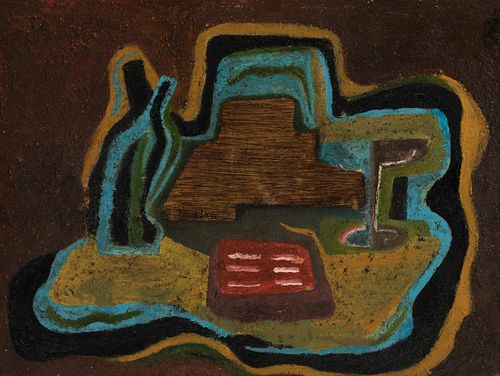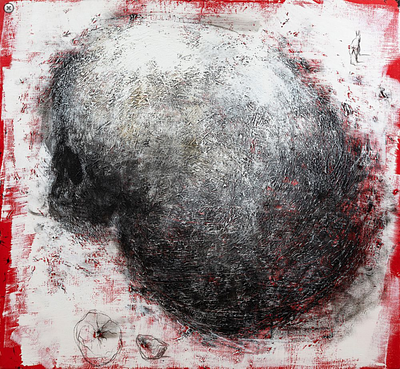JOAQUÍN PEINADO (Ronda, Málaga, 1898 - Paris, 1975). Untitled, 1926. Mixed media on panel. Enclosed is a certificate issued by Doña Rafaela Tarquín
Lot 80
About Seller
Setdart Auction House
Carrer Aragó 346
Barcelona
Spain
Setdart Subastas was born in 2004 and is currently the first online art auction in Spain with solidity, prestige and reliability guaranteed by our more than 60,000 users. Setdart has a young, dynamic and enterprising team ready to successfully manage the purchase and sale of art works through custom...Read more
Categories
Estimate:
EUR€10,000 - EUR€12,000
$10,416.67 - $12,500
Absentee vs Live bid
Two ways to bid:
- Leave a max absentee bid and the platform will bid on your behalf up to your maximum bid during the live auction.
- Bid live during the auction and your bids will be submitted real-time to the auctioneer.
Bid Increments
| Price | Bid Increment |
|---|---|
| EUR€0 | EUR€10 |
| EUR€200 | EUR€25 |
| EUR€500 | EUR€50 |
| EUR€1,000 | EUR€100 |
| EUR€3,000 | EUR€200 |
| EUR€5,000 | EUR€500 |
| EUR€10,000 | EUR€1,000 |
| EUR€20,000 | EUR€2,000 |
| EUR€50,000 | EUR€5,000 |
About Auction
By Setdart Auction House
Oct 19, 2021
Set Reminder
2021-10-19 08:00:00
2021-10-19 08:00:00
America/New_York
Bidsquare
Bidsquare : CONTEMPORARY ART
https://www.bidsquare.com/auctions/setdart-auction-house/contemporary-art-7701
Setdart Auction House sofia@setdart.com
Setdart Auction House sofia@setdart.com
- Lot Description
JOAQUÍN PEINADO (Ronda, Málaga, 1898 - Paris, 1975). Untitled, 1926. Mixed media on panel. Enclosed is a certificate issued by Doña Rafaela Tarquín, the artist's daughter. Slight arching on the panel. Signed and dated in the central area. Measurements: 30 x 41 cm; 47 x 57 cm (frame). In 1926 Joaquín Peinado was in Amsterdam to take part in the creation of the sets for the play directed by Buñuel, "El retablo de maese Pedro", by the composer Manuel de Falla. The relationship with the surrealist filmmaker began in 1923, when Peinado moved to Paris. During his stay in the French capital, he came into contact with the group of Spaniards, especially Picasso, who was a great influence on the artist during this period. An example of this is this cubist-inspired work, which bears certain similarities to the still life, executed in the same year and belonging to the collection of the Galería Valle Ortí in Valencia. Joaquín Ruiz-Peinado Vallejo was a Cubist painter, successor of Cézanne and spiritual son of Picasso, and one of the most outstanding representatives of the Spanish School of Paris. He entered the San Fernando School of Fine Arts in Madrid in 1918 and in the following years became a pupil of Cecilio Plá and Julio Romero de Torres, and was awarded a scholarship for three years at the Monastery of Santa María de El Paular, winning the El Paular Painting Prize in 1922. In 1923, once he had finished his studies, he went to Paris, where he settled permanently. There he attended the classes given at the Ranson, Colarossi and La Grande Chaumière academies, while at the same time he became interested in Cubist painting, an aesthetic he would personalise and maintain in his works. In 1924 he also showed his work at the Salons des Indépendants, Surindépendants and d'Automne. Nevertheless, from the city of the Seine he continued to be part of Spanish artistic life, taking part in the mythical First Exhibition of the Society of Iberian Artists in 1925, and illustrating the magazines "Litoral", "Gallo" and "La Gaceta Literaria", as well as "La flor de California" (1928) by José María Hinojosa. In 1926 he also won the Painting Prize of the Diputación de Málaga. Three years later, in 1929, he took part in two important exhibitions of avant-garde art in Spain: the Exhibition of Paintings and Sculptures by Spanish Residents in Paris, at the Botanical Gardens in Madrid, and the Regional Exhibition of Modern Art, at the Casa de los Tiros in Granada. He was also involved in the performing arts, like other artists of the time, participating in the films "Un perro andaluz" (1929) and "La edad de oro" (1930), by his friend Buñuel, and as a set designer and draughtsman for Feyder's "Carmen" (1925). In 1926 he also took part in the performance of Falla's "El retablo de Maese Pedro" in Amsterdam together with Buñuel, Cossío, Viñes and Ángeles Ortiz. In time, his artistic career would lead him to occupy a prominent position within the School of Paris; he would become director of the Painting Section of the Union of Spanish Intellectuals and later vice-president of the same, and UNESCO would appoint him delegate of the Section of Spanish Painters of the School of Paris. In 1946 he was also one of the organisers of the exhibition "Arte de la España Republicana. Spanish Artists of the School of Paris", held in Prague and, due to its enormous success, later also in Brno. From that date onwards his international exhibitions were frequent, both individual and collective, and he was grouped together with the best French art of the time. However, it was not until 1969 that a retrospective of his work was held in Spain; organised by the Dirección General de Bellas Artes and held at the Museo de Arte Español Contemporáneo in Madrid, this exhibition consecrated his figure in our country. In fact, that same year he was appointed a member of the Royal Academy of San Telmo in Malaga.
- Shipping Info
-
In-house shipping available. Please inquire at admin@setdart.com.
-
- Buyer's Premium



 EUR
EUR CAD
CAD AUD
AUD GBP
GBP MXN
MXN HKD
HKD CNY
CNY MYR
MYR SEK
SEK SGD
SGD CHF
CHF THB
THB

















